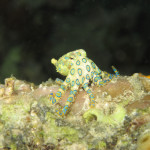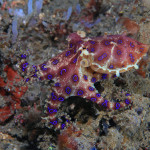Macro life often takes a backseat to the larger, more charismatic creatures, such as whales, sharks and turtles. But these tiny animals are equal to, if not more impressive, beautiful and unique than the larger, more easily identified creatures. The blue-ringed octopus is a standout species among them.
What is it?
The blue-ringed octopus is a small mollusk that could fit into the palm of your hand. It is named and categorized by the number of rings it possesses; for example, the lesser blue-ringed octopus and the greater blue-tinged octopus are the most common types. Even with their arms extended, they can be as small as two inches. This is the only octopus to contain the toxin tetrodotoxin, which is also found in pufferfish and cone snails, and they use it for self-defense. However, it has been said that as little as 1 milligram of toxin can kill a human, and there is no known antidote. Blue-ringed octopus feed mainly on small crustaceans like shrimp, crabs and small fish. They have an average lifespan of around two years, with both male and female dying during the reproductive process. The male dies immediately after the mating process, while the female dies of exhaustion after protecting her eggs for up to two months.
Where is it?
The blue-ringed octopus can be found in Australia, Indonesia, Philippines, Malaysia, Japan and New Guinea. Their habitat consists of rubble and reef, in cracks and on sandy bottoms. Some famous dive areas that frequently feature blue-ringed octopus include Lembeh Strait, Indonesia; Anilao, Philippines; and Mabul, Malaysia.
Why are they so hard to spot?
Blue-ringed octopus are hard to spot not only because of their obvious tiny size, but also because of their coloring. They can range in color from dark brown to a dark gold, giving them perfect camouflage for their habitat. They only flash their recognizable blue rings in defense, when feeling threatened. They are also difficult to spot on a dive, as they prefer to stay in more shallow water where most divers tend not to go. They can be difficult to photograph as they are easily spooked, meaning that they will flee quickly using their hydro jet, or lie flat on the sand and creep away.
How can you increase your chances of spotting one?
The best way to increase your chances to see one of these critters is by understanding its behaviors and habitats, as well as knowing where to dive and what habitat to search. To increase your chances of capturing one on camera, relax and don’t rush it, and set your camera settings and strobes before approaching the animal. If you can, try to use something in your shot as a contrast, either as a background or even another subject in the shot for scale. If the octopus does begin to flash in color or ink, then act responsibly and respectively towards it and keep your distance.
By Beth Alexander
The post Marine Species: The Blue-Ringed Octopus appeared first on Scuba Diver Life.

